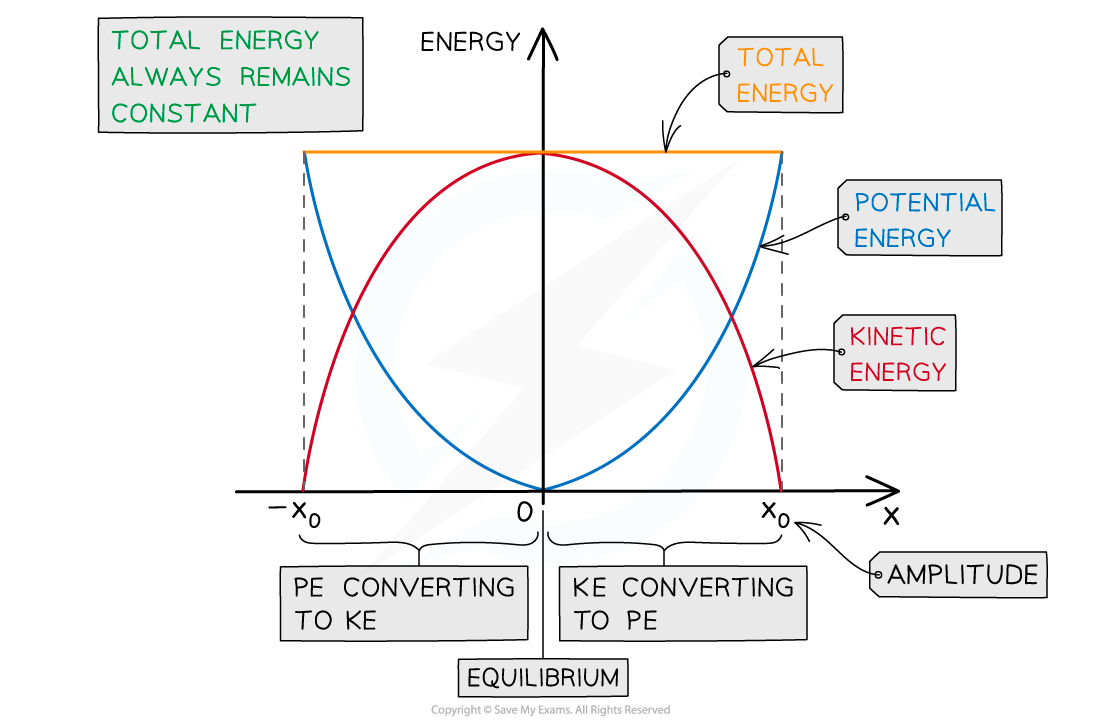Energy Changes in SHM
- During simple harmonic motion, energy is constantly exchanged between two forms:
- Kinetic energy
- Potential energy
- The potential energy could be in the form of:
- Gravitational potential energy (for a pendulum)
- Elastic potential energy (for a horizontal mass on a spring)
- Or both (for a vertical mass on a spring)
- The speed of an oscillator is at a maximum when displacement x = 0, so:
The kinetic energy of an oscillator is at a maximum when the displacement is zero
- This is because kinetic energy is equal to
so when the oscillator moves at maximum velocity (at the equilibrium position) it reaches its maximum value of kinetic energy
- Therefore, the kinetic energy is zero at maximum displacement x = x0, so:
The potential energy of an oscillator is at a maximum when the displacement (both positive and negative) is at a maximum,
- This is because the kinetic energy is transferred to potential energy as the height above the equilibrium position increases
- A simple harmonic system is therefore constantly converting between kinetic and potential energy
- When one increases, the other decreases and vice versa, therefore:
The total energy of a simple harmonic system always remains constant
- The total energy is, therefore, equal to the sum of the kinetic and potential energies

The kinetic and potential energy of an oscillator in SHM vary periodically
The key features of the energy-time graph are:
- Both the kinetic and potential energies are represented by periodic functions (sine or cosine) which are varying in opposite directions to one another
- When the potential energy is 0, the kinetic energy is at its maximum point and vice versa
- The total energy is represented by a horizontal straight line directly above the curves at the maximum value of both the kinetic or potential energy
- Energy is always positive so there are no negative values on the y axis
- Note: kinetic and potential energy go through two complete cycles during one period of oscillation
- This is because one complete oscillation reaches the maximum displacement twice (positive and negative)

Potential and kinetic energy v displacement in half a period of an SHM oscillation
- The key features of the energy-displacement graph:
- Displacement is a vector, so, the graph has both positive and negative x values
- The potential energy is always at a maximum at the amplitude positions x0 and zero at the equilibrium position (x = 0)
- This is represented by a ‘U’ shaped curve
- The kinetic energy is the opposite: it is zero at the amplitude positions x0 and maximum at the equilibrium position, x = 0
- This is represented by a ‘n’ shaped curve
- The total energy is represented by a horizontal straight line above the curves
Calculating Energy in Simple Harmonic Motion
- Using the expression for the velocity, v, of a simple harmonic oscillator:
- The kinetic energy, EK, of an oscillator can be written as:
- Since the maximum value of
or
is 1, maximum kinetic energy is given by:
- When the kinetic energy of the system is at a maximum, the potential energy is zero
- Hence this represents the total energy of the system
- The total energy, ET, of a system undergoing simple harmonic motion is, therefore, defined by:
- Where:
- ET = total energy of a simple harmonic system (J)
- m = mass of the oscillator (kg)
- ⍵ = angular frequency (rad s−1)
- x0 = amplitude (m)
- Note: The same expression for total energy will be achieved if the other expression for velocity is used:
- An expression for the potential energy of a simple harmonic oscillator can be derived using the expressions for velocity and displacement
- The key to deriving this expression is to use the trigonometric identity:
- In a simple harmonic oscillation, the total energy of the system is equal to:
Total energy = Kinetic energy + Potential energy
- The potential energy of an oscillator can be written as:
- Taking out a factor of
gives:
- Since
, the potential energy of the system can be written as:
- Since the maximum potential energy occurs at the maximum displacement of the oscillation, i.e.
:
- Therefore, it can be seen that:
Kinetic Energy–Displacement Relation for SHM
- Using the displacement–velocity relation for SHM:
- Substituting into the equation for kinetic energy:
- This leads to the kinetic energy–displacement relation for SHM:
Exam Tip
You may be expected to draw as well as interpret energy graphs against time or displacement in exam questions. Make sure the sketches of the curves are as even as possible and use a ruler to draw straight lines, for example, to represent the total energy.
